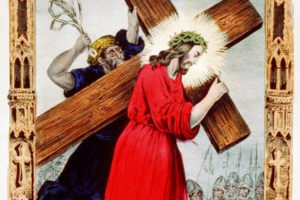
[embedded facebook post from Saint Michael’s Catholic Church in Stillwater, Minnesota, should load below, depicting Stations of the Cross with text captions]
I. Jesus is Condemned to Death
We adore you, O Christ, and we praise you, because by Your Holy Cross You have Redeemed the world. [genuflect]
II. Jesus Takes Up His Cross
We adore you, O Christ, and we praise you, because by Your Holy Cross You have Redeemed the world. [genuflect]
III. Jesus Falls the First Time
We adore you, O Christ, and we praise you, because by Your Holy Cross You have Redeemed the world. [genuflect]
IV. Jesus Meets His Afflicted Mother
We adore you, O Christ, and we praise you, because by Your Holy Cross You have Redeemed the world. [genuflect]
V. Simon of Cyrene Helps Jesus Carry the Cross
We adore you, O Christ, and we praise you, because by Your Holy Cross You have Redeemed the world. [genuflect]
VI. Veronica Wipes the Face of Jesus
We adore you, O Christ, and we praise you, because by Your Holy Cross You have Redeemed the world. [genuflect]
VII. Jesus Falls the Second Time
We adore you, O Christ, and we praise you, because by Your Holy Cross You have Redeemed the world. [genuflect]
VIII. Jesus Meets the Women of Jerusalem
We adore you, O Christ, and we praise you, because by Your Holy Cross You have Redeemed the world. [genuflect]
IX. Jesus Falls the Third Time
We adore you, O Christ, and we praise you, because by Your Holy Cross You have Redeemed the world. [genuflect]
X. Jesus Is Stripped of His Garments
We adore you, O Christ, and we praise you, because by Your Holy Cross You have Redeemed the world. [genuflect]
XI. Jesus Is Nailed to the Cross
We adore you, O Christ, and we praise you, because by Your Holy Cross You have Redeemed the world. [genuflect]
XII. Jesus Dies on the Cross
We adore you, O Christ, and we praise you, because by Your Holy Cross You have Redeemed the world. [genuflect]
XIII. Jesus Is Taken Down From the Cross
We adore you, O Christ, and we praise you, because by Your Holy Cross You have Redeemed the world. [genuflect]
XII. Jesus Is Laid in the Tomb
We adore you, O Christ, and we praise you, because by Your Holy Cross You have Redeemed the world. [genuflect]










